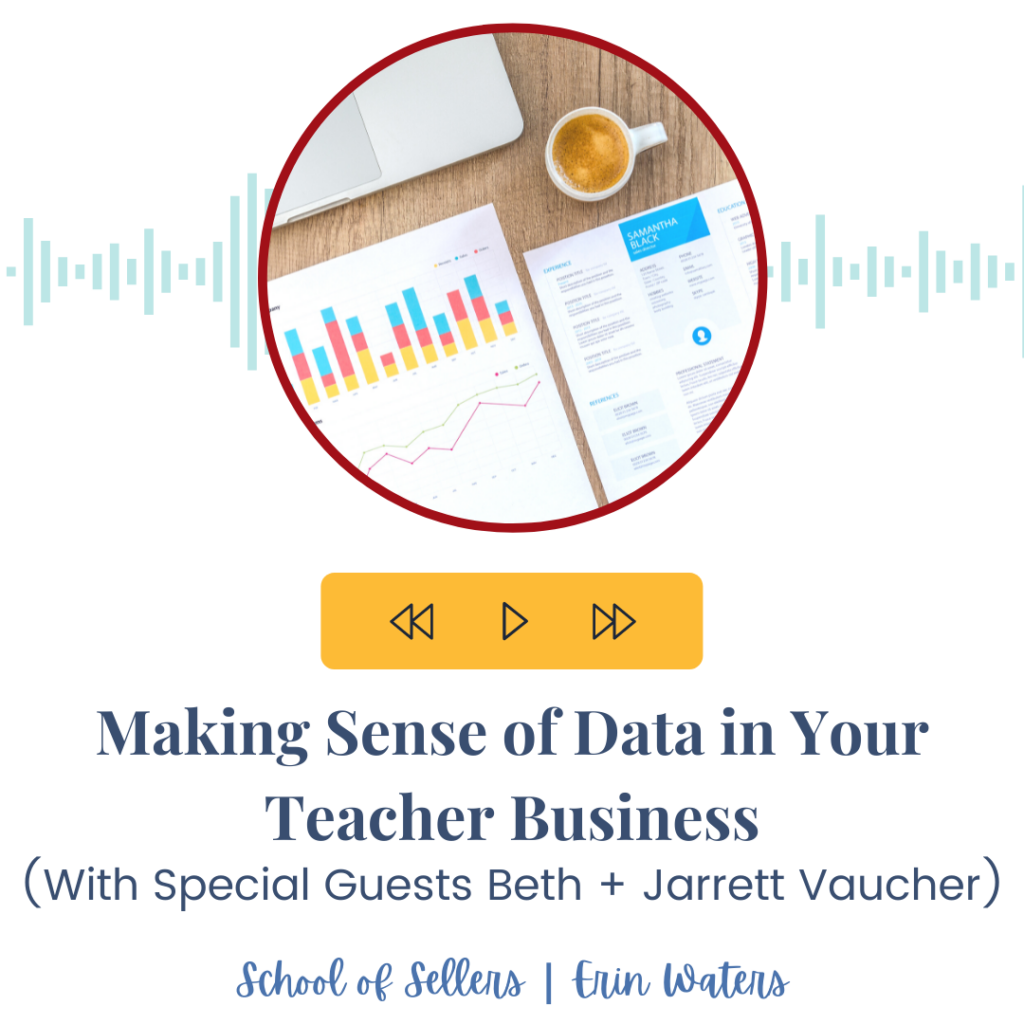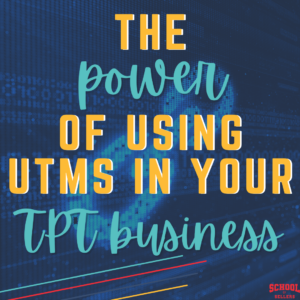Episode Summary
Not only is the sheer amount of data intimidating, but once we sort through it we are expected to make informed decisions about what to do next. Jarrett + Beth Vaucher from Your Data Playbook are here with me to break it all down. There’s a lot of pressure to use our data, but where do we start? What numbers matter? What does it all mean? Beth and Jarrett are here to help!

This post may contain affiliate links. As an Amazon Associate, I earn from qualifying purchases.
Introduction
Erin: I am so excited to introduce you to our guests today. Beth and Jarrett are here to join me. And you may have seen me raving about this power duo on social media. But if you don’t follow them, Beth is a TpT seller and her husband Jarrett is a data analysis wizard. With their powers combined, they have created Your Data Playbook which is a membership for TpT sellers that basically hands you your data on a silver platter and tells you what to do with it.
And I’m only kind of being dramatic when I say that. It’s almost that good. So anyways, I’m just really glad to have Beth and Jarrett on the show today because I have had Your Data Playbook for months now. It has changed the way that I run my business. And in fact, all of Team SOS have Your Data Playbook. So if that’s any indication of how much we believe in it, there you go.
I am so excited today to welcome Beth and Jarrett to the show. Beth and Jarrett are a power couple times a hundred, and I’ll let them introduce themselves here in a moment. But I am really excited to have them on the show today because they have recently helped me a lot with my own business. So I know they have a ton of good stuff to share with you guys. So why don’t you guys just kind of give us some background? Like Beth, how you got started on TpT, how Jarrett became involved, and just what you guys are up to now.
How Beth + Jarrett Got Started with TeachersPayTeachers
Beth: All right. Well, we’re so excited to be on the show. I’m Beth and I started TpT about six years ago when I was pregnant with our oldest daughter Isabella. I know I was going to stay home from teaching. And it kind of just started as a hobby of a few teachers encouraged me with stuff I had made. They’re like, oh, you should sell on TpT. So it was kind of a no-brainer because I was going to stay home anyways and liked creating.
And then I started thinking about my needs as a teacher. At the time when I first started teaching, I was in Chicago and had a lot of ELL students and really did not have any support from the school of what to do for them, especially the newcomer students who didn’t speak any English. And I was a homeroom teacher, had no resources to help the students. And I thought, you know what? There has to be other teachers like me that are receiving newcomers in their mainstream classroom and really have no idea what to do and want to do something.
So that’s kind of where my niche started off was really realizing this need of supporting ELL newcomers. We lived abroad in Panama and I have a minor in Spanish but took years of it and never really could speak it. So I knew the frustration of learning a language and how hard it is. And then living abroad and feeling the frustration of being a second language learner and the embarrassment that comes with it.
All of these things kind of meshed together. And then this is really where my passion formed was creating resources for ELL students. Jarrett was super supportive even when since the beginning. Like he could see I really had that creative outlet and was able to still stay with education and into what was happening but be at home and be with our daughter. And so he was super supportive. And then he started getting involved and saying like, oh, this is actually, this could really become a business and like, let’s try this and this. So I had no business background. I had no idea what I was doing. All I wanted to do was create resources. And so that’s kind of where he came into the story.
How Beth + Jarrett Got Started with Your Data Playbook
Jarrett: Creating, right? She loves it, and she’s really good at it, right? And so I have a business background. I’m a business guy with a strategy and data background. I worked work one of the leading airlines in all of Latin America. And so my job actually was using the data that we had, and again, in a service industry, data is key, right? So we flew to over 80 countries and basically you have to figure out where to optimize your network. And so you need data for that.
I was in charge of managing the commercial analytics team, and my job was to make sure that butts were in planes, right? You got to fill up the planes before they take off because that’s how you make money. So again, my background is in data. And so as I started to look at Beth and her creative process and how she was creating products and starting saying, oh, hey, this product is starting to get traction and starting to look on TpT. Hey, this definitely is getting, this has potential. I started to get more intrigued about what she was doing. Obviously, very supportive and giving her tips and if she asked for feedback. But yeah, letting her drive the ship, right?
So and then just as I started to see how she was developing her business, I was like, well, just started asking some simple questions like why are you still creating this product if this right here sold 30 units last week and you made a thousand dollars? Like why aren’t you trying to do this? She’s like, oh, I didn’t know that. So just simple like questions like that just about visibility of how she was running her business and the fact that it just made me start to get involved more and try to help.
Like hey, there’s potential here. You just created 15 products last week, but you didn’t do anything to actually figure out how to sell more of the product that you already have, right? So it’s those types of conversations that really help me gravitate towards her even more and say, hey, babe, like I think you’re doing a great job and you obviously have a market here. There’s demand. But how can we do this better so that you’re not just on a hamster way of creating products even though you love it?
And again, not against product creation but how do we actually sell more of what you already have available in the market, right? So that was really like the genesis of how I started getting more involved and looking at her data and understanding what was actually working and what wasn’t working. So that’s how I started like being her sidekick, right?
Beth: The data guy.
Erin: I love that because my husband and I are also a TpT duo. Right now, his main job is taking care of our kids. But then when they go back to school, it’ll be back to running the business together. I also can obviously relate to Beth loving product creation because the biggest thing that I’ve taken from the stuff that you guys have helped me with already is just how important it is to focus on what you already have.
I think it’s the creative spirit inside of us that we think we always have to be creating new stuff. But you’re right. There’s so much power in the untapped resources that are already in our store. And so I came across you guys kind of multiple pathways I feel like because I saw you present your data session at the conference. Was that just last year, not this recent one?
Jarrett: Yeah, 2020.
Erin: And so and then you guys have been marketing Your Data Playbook membership which I want you to share about, and it has just transformed my business in the way that I am able to focus now on what I already have in my store and I don’t feel that pressure now to always be churning out brand new products all the time.
Jarrett: Hallelujah. I love hearing that! Again, you guys, teacher sellers I think, are just amazing. And so the fact that if we can add value and it takes some stress off your plate and makes you more effective, then I celebrate that. That’s a win for sure. And obviously, we’re still getting started. But that right there is why we’re doing what we’re doing! We want to make you guys more effective and get better return on the time that you’re investing because we know you’re juggling so many things. Everybody’s in the same boat in a lot of things. So yeah, that’s like the heart of why what we’re doing and we’ll get to that in a second I know. But I got excited hearing that because that’s the motive behind why we started.
The Importance of Data in Your TpT Business
Erin: Well, and I think I speak for many sellers when I say that we’ve always known that data is important and we’ve talked about data informed decisions and everything like that. But the way that you guys present it and deliver it makes it actionable. You don’t just tell us what the deal is but you tell us how to solve it and what to do next.
So I think we just need to dive into all of these questions about data because I’m really excited for you guys to be able to share Your Data Playbook membership. Why don’t you just give a little synopsis of the membership itself so people know what we’re referring to as we kind of mention it throughout our conversation? Because we will take a deep dive into the data side, not just the membership. But I’m going to keep talking about it because I love it so much so you might as well just give a little teaser about it and what you guys do for sellers.
Your Data Playbook
Jarrett: So the reality is like what you said, Erin. So many sellers know that data is important and especially being a digital business. What’s behind digital, right? Data is behind digital. Data is fueling the digital economy, and it will continue to do so. That’s not going to change because things are getting even more digital, right? And so the transformation just accelerated.
I have a heart for data. I’ve always liked data and data in business and then seeing you guys, like hey, there’s a lot of opportunity to unlock value for you guys, the teacher seller community. But there’s a lot of hurdles. And again, I’ve heard you also refer to accidental entrepreneurs. It’s true. A lot of you have an education background but you guys are so great at being entrepreneurs. So how can I come around and say, hey, this is the skillset that I have to add value to the community.
There can be a lot of barriers when it comes to even getting data, let alone what to do with it. One of them is just access. How do you actually get the data, right? And then it can be manual, downloading it and transforming it. How do you put it into a format that actually is usable? And then when I actually download it, what do I do with it? So we try to eliminate those barriers! What we’re doing in Your Data Playbook is essentially combining automation.
We do the heavy lifting for you, make your data into a consumable format that you can actually understand, and then we deliver it to you and give you actionable insights of how to take action. Because I think the biggest gap that I see most frequently is I can get the data but I don’t know what to do with it. So how do I transform it and how do Interpret it into something that’s actionable?
YDP is a Combination of Automation, Visual Analytics, and Coaching
Jarrett: So that’s really what we’re about. It’s combining automation with visual analytics. Visual analytics, just how your brain works, right? The science behind how we process the information visually, way faster. So if you create data and make it a visual format, it’s going to be way easier to understand and interpret.
And then there’s the coaching and enablement side. We know that data literacy is a journey, right? It’s just like learning how to read. It takes time. And so developing that mindset of becoming data driven takes time. So it’s really those three components, combining automation, visual analytics, and coaching and enablement really combined into one membership. We can provide value based out of my passion first to support Beth and say, hey, you guys also probably have the same problem, how can we help you do the same thing. And that’s what we’re doing. We’re still early on in our journey, but that’s where we’re at.
Erin: That’s awesome. Well, I think you hit the nail on the head about just data being confusing to most people and knowing that it’s important obviously but knowing what to do with it. And I love the way that you guys send these reports because I all of a sudden have information in my inbox saying, here’s what’s going on with this product. In order to try to improve it, here’s what you should do. And it’s just been such a lifesaver. So if you had to pick some must do’s in terms of TpT statistics, what do you guys view as like the most important data that we get from our dashboard or statistics on TpT?
Using Data from Your TpT Dashboard and Product Statistics
Jarrett: I think the most important obviously is your earnings, right? At the end of the day, if you’re on TpT and you’re trying to get serious about it, it’s earnings. Like simple. And how are your earnings? Basically the formula is hey, I have my product price times the number of products I’ve sold which gives you your earnings. So just looking at your earnings and then saying, okay, this earning is up or this is down but what’s behind those earnings?
What are the most important drivers actually leading to sales?
Jarrett: What are the drivers actually producing my sales? Is it traffic based or is it conversion or is it both, right? Were my earnings up this period versus last period or not? And if they weren’t, why not? Was it traffic related? Did this product have more traffic or did it not? How did it have less? Okay. If it had less why, right? So it’s like going through a decision tree. If it had less traffic because I promoted it last year on Facebook and Pinterest. But I didn’t do that this year. So look at the drop in my traffic. Now I know I might want to promote it again.
Or maybe it’s like specific to price. Maybe you raise the price and you see a huge drop in your conversion and as a result, your earnings. You sold less units, right? So it all really comes back I would say, it’s the simplest form in earnings but it’s how you look at earnings and then you say, what supports those earnings?
So how do I get to those earnings? In reality, it’s simple, just number of units sold times the price that they were purchased at. And then backing out of that and saying, okay, what drove those purchases and those units to be sold and what did people pay for those units when they bought them? That’s really at the simplest form, it’s that equation. Earnings is equal to number of units sold times the price that was paid. So if you just start there, and again, it sounds simple but just ask yourself, what’s behind those earnings? That’s what I would say.
Erin: Well, I think that’s so important because I feel like a lot of us just kind of stop there and don’t know where to look beyond that. So I like the fact that you used the decision tree in explaining because that’s kind of how I think about it. Like we see at the very top of things like what’s doing well and what’s not, but then it’s like you almost have to sort through then like the different layers to get to the bottom of what’s actually going on.
In my head, it’s like first, think about the number of views a product is getting. And then based on if it’s doing well or not view wise, then you look at other factors. So it is. It’s almost like a choose your own adventure, trying to sift through all of the results to see what is going on. Whenever you guys send your data and all the information that I use to optimize my products, it’s almost like I feel like I’m performing like first aid on my products in a way.
And I feel like there are the same scenarios happening again and again in my store which are great because I feel like the more it happens, the more I learn about my products. But what are some common situations you see happening with product statistics and then some easy like Band-Aid fixes we can give to those products for people listening who might be like, oh my gosh, data’s overwhelming, like what little things could I do?
What are some small “Band-Aid” fixes I can do with my TpT products based on data?
Jarrett: We’ve created the visual analytics and how we deliver them because it can be overwhelming. And so we really thought through the design behind how everything’s structured because the way you get it, you get such a massive data in the TpT download. TpT gives a ton of data, and you can’t see everything in one view, right? So if you actually can see one variable and look how it relates to the other, then you get the full picture to actually understand the pulse of how your business is working.
So I think with that context, let’s say you have a high traffic product, right? But it has really low conversion. That’s a great place to start because that’s a missed opportunity. Let’s say it’s a $5 product. And it’s getting the most daily views out of anything in your entire portfolio. Yet it has a conversion of less than the average. And the average, as we’ve studied, is about 6%. So again, let’s say it’s a below average conversion rate, you’re going to say why is that and dig in to see. You might think, I’m missing opportunity here but this gets a lot of traffic. Why doesn’t it convert?
So anything you have in your store that’s high volume in terms of views but has a lower conversion rate is a great place to start! You have to look at it and say, okay, I’m getting a lot of people that are viewing my products but I’m not getting a lot of people to actually go and see my preview, right? So the preview is the most important besides price. TpT has stated 62% of purchasers say that the preview is the most impactful driver of conversation, right?
Converting Shoppers to Buyers
So how are you thinking about your thumbnails? Are your thumbnails leading into the preview so that people understand that hey, you want people to click your preview because statistically speaking, that’s going to be your biggest helper. Your description helps too, right? But it’s secondary. Ultimately, what they see showcased is most important for converting shoppers to buyers. You have to tell them and show them in your preview hey, this is what this product’s about. If you get them there, the probability goes way up that they’re going to purchase.
Erin: Yes, that’s a good point. It’s almost like just getting them to that finish line. Like once they see your product, wherever their first exposure is, how do you get them to the very end? And it’s kind of cool to put yourself in their shoes and think about what they’re seeing at different times and what’s influencing their decisions. So I think something like a thumbnail update is so doable. It’s something that can be done in less than half an hour if you really put your mind to it, and it could have the biggest impact.
To be totally honest, that was really not on my radar a year or two ago when it came to running my store. So again, just another vote for data. I wouldn’t be thinking about any of these things. And I also wanted to point out too that it’s really helpful to have go-to tasks like that. Like if this is low, then do this.
Because if you are also a seller in a situation where you are hiring VA’s and having other people work on your business, those end up being really good tasks to then hand off to other people as well. I’ve kind of been like stockpiling my own list of things once we get VA access on TpT. That’s a whole other conversation. I will just be like funneling the Your Data Playbook information directly to them because it’s all doable and I love it.
What To Do with Products That Are Converting a Little *Too* Well
Jarrett: I just thought of another one, Erin, high-converting products! If you have a product with a high conversion rate, anything over 8%, ask yourself if you’re leaving money on the table. I think people in the community don’t like to play with pricing optimization, right? But having visibility in your data, actually anything over 8% is like hey, are you underpriced? Are you adequately valuing your product? Maybe you’re leaving money on the table. If you shift a product a couple dollars, remember that’s an incremental couple dollars every sale. And if you sell a thousand of those in a year, that’s a couple thousand dollars just by making a couple shifts.
Literally, that’s the quickest money you can make if you go in and edit your product within your product listing. Hey, change the product from $10 to $12, and then look to make sure it doesn’t impact too much. Let’s say that product is running at 12%, 13% and now it’s 9%, 10%, that’s still a tremendous conversion rate and your incremental revenue goes up. So that’s a really quick change as well. And you can actually monitor that in your data and say hey, I’ve changed this date. Let’s go look at the conversion rate and see if volume of units and my conversion rate, what does it look like, right? And was that a helpful change or not, right? So those are simple wins like that don’t take a lot of effort at all really.
After I make a change to a product, how long should I wait to see if it was effective or not?
Erin: How long would you say is a good window of time, like once you make an adjustment like that, how long would you give it safely to really be able to tell if it’s effective or not?
Jarrett: That’s a great question. It’s really not a function of time, but more of a function of page views. It’s really a matter of you want traffic to that particular product because it’s all about gathering data points to be able to make it statistically significant. Hey, I did this change. It’s essentially hypothesis testing. I have a hypothesis that I can sell X more if I change this price.
A product needs at least 300-500 views in a period to make sure data is statistically significant. We’re actually creating templates, almost like a mortgage calculator in the membership where you can go in now and plug that in using the data that we provide you. So that’s something that we’re working on the road map because it is a very common question. It’s like okay I have this other visibility, but I don’t want to actually have to think and do the math. I just want to plug it in and get the output.
But it’s not a function of time. It’s more a function of trafficking, actually getting the amount of traffic necessary to see if it’s statistically significant. And when I say statistically significant, really all I’m saying is it’s not a matter of chance that it went up or down, right? The action that you took influenced the outcome. That’s really what we’re talking about.
Erin: So to go back to, so you guys, did you say you currently have a tool where you can like do hypothetical pricing situations?
Jarrett: So we have one post change. What we’re working on right now in part, kind of like you and your templates but we’re actually doing for like hey, here’s different scenarios for data. You can plug them in here with the tools that we provide. So it’s just like a support or supplement. So that’s what we’re working on based, again, on feedback that we received and just, again, continuing to innovate and iterate on the product and make it more effective for you guys. Again, trying to make it easier and more valuable so that you can be more effective.
Erin: That’s such a cool tool because I think teachers, we tend to like lead businesses with our hearts sometimes and we shouldn’t. And so we feel bad raising prices. And I think that’s one of our biggest like not weaknesses, but we definitely tend to like undervalue everything. So to have something that could black and white say, you should do this and raise it by this much or here’s what maybe would happen. I love that ability to adjust prices without all the feelings.
Jarrett: It’s coming. Literally, we’re working on it this last week and this week. So it’s in the pipeline. Yeah.
Erin: So awesome!
Your Data Playbook Is Specific to the TpT Marketplace
Beth: And it’s nice because it’s for our marketplace. Because I think a lot of us get a lot of business advice from other people in different industries and then we try to apply it to ours and it’s a very different marketplace. So it’s nice to have these tools that are with just the TpT data and looking and focusing on that and giving us that guidance based upon.
Erin: Totally. Well, I mean even just the conversion rate alone, I know there are going to be so many listeners who are like, thank you for telling me what the TpT conversion rate is because the industries are all over the place when you look at the average. So it helps to have, like you said, TpT specific information because we definitely don’t get that enough.
I know so many sellers are going to be so grateful for you guys and Your Data Playbook membership. If people are listening and want to learn more about Your Data Playbook, we actually have a School of Sellers landing page set up to share information about data and this episode. But beyond that, which I will share in the show notes, where can I find you guys online in terms of, do you have a Facebook group or just the best way of contact, website to find out more about what you guys have to offer?
Jarrett: Yeah, you can just go to YourDataPlaybook.com, and it has the sales page, what we’re offering, and then there’s an open Facebook group. We have a private Facebook group for the membership, and we also have an open one called Data Driven Teacherpreneurs. You go on that. And so you can also put any questions there. Or we have a contact us at the bottom of the website as well, and you can shoot us a message and we’ll try to get back to you as soon as possible. But you know how that goes, balancing everything.
Erin: Oh yes.
Jarrett: Growth pains, right? Yeah.
Beth: I want to share if you are listening right now, and you are like, data is way overwhelming, like no thank you, I relate to you. I am not a data person, and like Excel sheets are probably our biggest fights because I’m just like, I don’t want to look at Excel sheets. Visually, they’re just really terrible. I can’t even interpret what you’re telling me to do. So if you are feeling that, we have really worked on how to make it really practical, tangible steps to take. I mean it’s honestly freeing to know like here are the products I need to focus on and here’s five tasks that I need to do, like update the cover or really simple tangible tasks.
And like Erin’s saying, that can be hired out. I mean so it just feels very empowering to become more data driven, and it’s a process. And we’re all making those questions to ask and kind of on this journey together to become more data driven. So it’s really fun to be in a community like that. But I know sometimes when I hear the word data, it’s like, I know that I should like go that route, but I have no idea. So that is me. So Jarrett and I talk a lot, and I kind of make sure like this is in simplest form so that those who really have had no experience with data or don’t have a math background are able to still engage with the data.
Erin: Yeah, like talk to me like I’m five, and tell me.
Jarrett: I’m working on getting better at that honestly. So it’s a learning journey for me how to, because again, you guys have such knowledge and understanding of your business. So how do I just come in and enhance that? And one of the frameworks like she’s talking about, it’s like focus optimized drive. I want you to be liberated to be able to focus on your area of genius, but you also have to run your business.
So like hey, these 12 products made 80% of your earnings this year. Do something to promote those and grow your bottom or your top line, right? So that’s what we’re passionate about is like cutting through the noise and making it easy for you to use and translate it into action. And again, we’re on a journey just like you guys, and we’ll get better. But I believe that becoming data driven is accessible to anyone. I firmly believe that. It’s not just for the data geeks like me. But you guys, you’re in it and the value of it and we want to help unlock that value for you. So that’s what we’re doing.
Erin: Well, you guys are awesome at what you do, and you’ve already been so amazing at taking the feedback from the community and reworking everything in Your Data Playbook. So I think that’s one of the best qualities of joining is just the level of support that you get. But I just have to say I love that you said it’s empowering, Beth. Like that is the best word I can think of to describe how I feel about my business now that I have the data and the guidance for what to do with it. So I agree. For anyone who’s like on the fence about data because it’s intimidating, this is not your average data situation.
Beth: And if you use the Finishing Framework from Erin, then you have the time to batch and you can batch your data day. You just do it all and you spend an hour or two and you really can make huge progress and strides in your business, some really small tweaks. So I mean that’s the beauty of it. It’s not like this overwhelming adding it onto your plate.
Erin: Right. It’s not something new and I think that is like what everyone is like not wanting right now is just another new thing to add. So yes, that is so true. Well, I thank you guys so much for being on the episode today.

Fun Questions with Beth + Jarrett
Erin: I’m actually going to ask you a couple lightning round questions if you’re okay with that just for fun? If you were going on a desert island for a month, what three items would you bring with you to run your business?
Beth: A computer obviously.
Jarrett: Computer. Does the island have internet?
Erin: The island has internet. Yeah.
Beth: I would say computer, coffee, and each other.
Erin: Aww.
Jarrett: I would say a computer, coffee, and a soccer ball.
Erin: Okay. Tacos or pizza?
Beth: Pizza. I think pizza is one of the biggest things that’s transformed the world.
Jarrett: I’m going tacos if I had a choice. Good tacos every day all day.
Beth: I’m still dreaming about this island.
Erin: I know, right? Maybe that can be another TpT conference destination.
Beth: Yes. We actually met on a remote island in Panama. But that’s for another day.
Erin: Okay. Last one. I feel strongly about this one. PC or Mac?
Beth: Mac for me for sure.
Jarrett: Mac.
Erin: Okay. Mac.
Jarrett: And I have a PC.
Erin: You have a PC?
Jarrett: Yeah, and I hate it.
Erin: Yeah? I thought about getting one just to kind of like check to see if things are compatible on both devices like for TpT products.
Beth: People will let you know.
Erin: I’d hate to subject myself to that if I don’t have to.
Jarrett: Shifting to the creative side now, like the last six to eight months, like working towards that full time, yeah, Mac just kicks the pants off PC when it comes with like active creative output.
Beth: It’s a good one. It is. Never go back.
Erin: Oh my goodness. What a wealth of information. Thanks again to Beth and Jarrett for their never ending data support and wisdom. You guys are amazing. That’s all for this week, my friends. I will see you here again next week same time same place.
Conclusion
Links mentioned in this episode:
Looking for another way to get this episode? Download the transcript for Making Sense of Data in Your TpT Business here!

Subscribe to the show!
Are you subscribed to the School of Sellers podcast yet? If not, I want to encourage you to do that today so you never miss an episode. Subscribe on Spotify, Apple Podcasts, Stitcher, Amazon Music, or Google Podcasts!
If you’re feeling generous, I would be eternally grateful if you left me a review over on Apple Podcasts, too. Reviews help other sellers find my podcast just like you. Thank you!
Let’s connect!
Follow us on the podcast, the Facebook group for new sellers, the Facebook group for established sellers, YouTube, Instagram, and TikTok!





